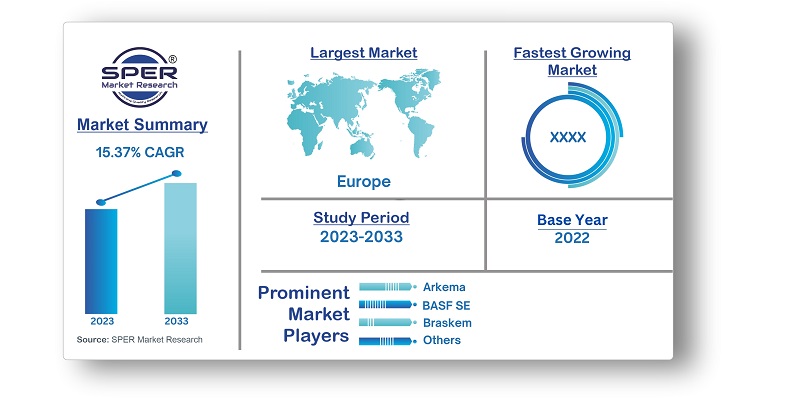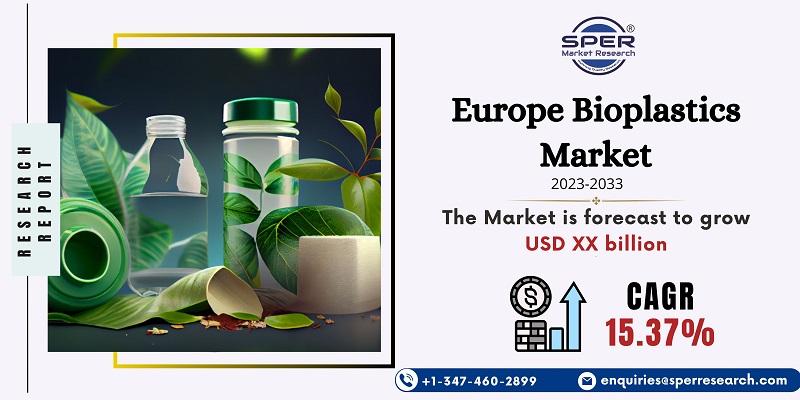
Europe Bioplastics Market Growth, Size, Trends, Challenges, Opportunities and Future Outlook
Europe Bioplastics Market Size- By Product Type, By Application - Regional Outlook, Competitive Strategies and Segment Forecast to 2033
| Published: Feb-2024 | Report ID: CHEM2419 | Pages: 1 - 159 | Formats*: |
| Category : Chemical & Materials | |||
- In February 2022, Carbios and Indorama Ventures announced their collaboration to process bio-recycled PET in France, with a projected 50,000-ton processing capacity.


| Report Metric | Details |
| Market size available for years | 2020-2033 |
| Base year considered | 2023 |
| Forecast period | 2024-2033 |
| Segments covered | By Product Type, By Application |
| Regions covered | Germany, Australia, Switzerland, France, Great Britain, Spain, Italy |
| Companies Covered | Arkema, BASF SE, Braskem, Corbion, Danimer Scientific, Dow, Kaneka Corporation, Futerro, Maccaferri Industrial Group, Mitsubishi Chemical Corporation, Natureworks LLC, Novamont SpA, Solvay, Others. |
- Industrial Manufacturers
- Packaging Industry
- Agriculture Sector
- Automotive Industry
- Consumer Goods Companies
- Healthcare and Medical Sector
- Government and Regulatory Bodies
| By Product Type: |
|
| By Application: |
|
- Europe Bioplastics Market Size (FY’2024-FY’2033)
- Overview of Europe Bioplastics Market
- Segmentation of Europe Bioplastics Market By Product Type (Bio-based Biodegradables, Bio-based Non-biodegradables)
- Segmentation of Europe Bioplastics Market By Application (Flexible Pakaging, Rigid Packaging, Automotive and Assembly Operations, Agriculture and Horticulture, Construction, Textiles, Electrical and Electronics, Others)
- Expansion Analysis of Europe Bioplastics Market
- Problems and Obstacles in Europe Bioplastics Market
- Competitive Landscape in the Europe Bioplastics Market
- Impact of COVID-19 and Demonetization on Europe Bioplastics Market
- Details on Current Investment in Europe Bioplastics Market
- Competitive Analysis of Europe Bioplastics Market
- Prominent Players in the Europe Bioplastics Market
- SWOT Analysis of Europe Bioplastics Market
- Europe Bioplastics Market Future Outlook and Projections (FY’2024-FY’2033)
- Recommendations from Analyst
1.1. Scope of the report1.2. Market segment analysis
2.1. Research data source2.1.1. Secondary Data2.1.2. Primary Data2.1.3. SPER’s internal database2.1.4. Premium insight from KOL’s2.2. Market size estimation2.2.1. Top-down and Bottom-up approach
2.3. Data triangulation
4.1. Driver, Restraint, Opportunity and Challenges analysis4.1.1. Drivers4.1.2. Restraints4.1.3. Opportunities4.1.4. Challenges
4.2. COVID-19 Impacts of the Europe Bioplastics Market
5.1. SWOT Analysis5.1.1. Strengths5.1.2. Weaknesses5.1.3. Opportunities5.1.4. Threats5.2. PESTEL Analysis5.2.1. Political Landscape5.2.2. Economic Landscape5.2.3. Social Landscape5.2.4. Technological Landscape5.2.5. Environmental Landscape5.2.6. Legal Landscape5.3. PORTER’s Five Forces5.3.1. Bargaining power of suppliers5.3.2. Bargaining power of buyers5.3.3. Threat of Substitute5.3.4. Threat of new entrant5.3.5. Competitive rivalry5.4. Heat Map Analysis
6. Competitive Landscape
6.1. Europe Bioplastics Market Manufacturing Base Distribution, Sales Area, Product Type7. Europe Bioplastics Market, By Product Type (USD Million)
6.2. Mergers & Acquisitions, Partnerships, Product Launch, and Collaboration in Europe Bioplastics Market
7.1. Europe Bioplastics Market Value Share and Forecast, By Product Type, 2024-2033
7.2. Bio-based Biodegradables7.2.1. Starch-based7.2.2. Polylactic Acid (PLA)7.2.3. Polyhydroxyalkanoates7.2.4. Polyeter7.2.5. Others7.3. Bio-based Non-biodegradables7.3.1. Bio-polyethylene Terephthalate7.3.2. Bio-Polyethylene7.3.3. Bio-Polyamides7.3.4. Bio-Polytrmethylene Terephthalate7.3.5. Others
8.1. Europe Bioplastics Market Value Share and Forecast, By Application, 2024-20338.2. Flexible Pakaging8.3. Rigid Packaging8.4. Automotive and Assembly Operations8.5. Agriculture and Horticulture8.6. Construction8.7. Textiles8.8. Electrical and Electronics8.9. Others
9.1. Europe Bioplastics Market Size and Market Share
10.1. Europe Bioplastics Market Size and Market Share By Product Type (2020-2026)10.2. Europe Bioplastics Market Size and Market Share By Product Type (2027-2033)
11.1. Europe Bioplastics Market Size and Market Share By Application (2020-2026)11.2. Europe Bioplastics Market Size and Market Share By Application (2027-2033)
12.1. Europe Bioplastics Market Size and Market Share By Region (2020-2026)12.2. Europe Bioplastics Market Size and Market Share By Region (2027-2033)12.3. Germany12.4. Australia12.5. Switzerland12.6. France12.7. Great Britain
12.8. Spain
12.9. Italy
13.1. Arkema13.1.1. Company details13.1.2. Financial outlook13.1.3. Product summary13.1.4. Recent developments13.2. BASF SE13.2.1. Company details13.2.2. Financial outlook13.2.3. Product summary13.2.4. Recent developments13.3. Braskem13.3.1. Company details13.3.2. Financial outlook13.3.3. Product summary13.3.4. Recent developments13.4. Corbion13.4.1. Company details13.4.2. Financial outlook13.4.3. Product summary13.4.4. Recent developments13.5. Danimer Scientific13.5.1. Company details13.5.2. Financial outlook13.5.3. Product summary13.5.4. Recent developments13.6. Dow13.6.1. Company details13.6.2. Financial outlook13.6.3. Product summary13.6.4. Recent developments13.7. Kaneka Corporation13.7.1. Company details13.7.2. Financial outlook13.7.3. Product summary13.7.4. Recent developments13.8. Futerro13.8.1. Company details13.8.2. Financial outlook13.8.3. Product summary13.8.4. Recent developments13.9. Maccaferri Industrial Group13.9.1. Company details13.9.2. Financial outlook13.9.3. Product summary13.9.4. Recent developments13.10. Mitsubishi Chemical Corporation13.10.1. Company details13.10.2. Financial outlook13.10.3. Product summary13.10.4. Recent developments13.11. Natureworks LLC13.11.1. Company details13.11.2. Financial outlook13.11.3. Product summary13.11.4. Recent developments13.12. Novamont SpA13.12.1. Company details13.12.2. Financial outlook13.12.3. Product summary13.12.4. Recent developments13.13. Solvay13.13.1. Company details13.13.2. Financial outlook13.13.3. Product summary13.13.4. Recent developments13.14. Others
SPER Market Research’s methodology uses great emphasis on primary research to ensure that the market intelligence insights are up to date, reliable and accurate. Primary interviews are done with players involved in each phase of a supply chain to analyze the market forecasting. The secondary research method is used to help you fully understand how the future markets and the spending patterns look likes.
The report is based on in-depth qualitative and quantitative analysis of the Product Market. The quantitative analysis involves the application of various projection and sampling techniques. The qualitative analysis involves primary interviews, surveys, and vendor briefings. The data gathered as a result of these processes are validated through experts opinion. Our research methodology entails an ideal mixture of primary and secondary initiatives.



Frequently Asked Questions About This Report
PLACE AN ORDER
Year End Discount
Sample Report
Pre-Purchase Inquiry
NEED CUSTOMIZATION?
Request CustomizationCALL OR EMAIL US
100% Secure Payment






Related Reports
Our Global Clients
Our data-driven insights have influenced the strategy of 200+ reputed companies across the globe.




















